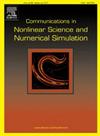探讨了用于消除粘性颗粒系统中粘性接触模型中非物理吸引力的最佳阻尼因子
IF 3.8
2区 数学
Q1 MATHEMATICS, APPLIED
Communications in Nonlinear Science and Numerical Simulation
Pub Date : 2025-06-10
DOI:10.1016/j.cnsns.2025.109074
引用次数: 0
摘要
由于恢复阶段末期的非物理引力严重扭曲了颗粒系统中的碰撞行为,本研究旨在制定三种策略来消除非物理引力,以改善粘性接触力模型的不足。根据粘性阻尼力的特点,确定了去除粘性阻尼因子非物理引力的优化原则。第一种方法根据滞回阻尼和粘性阻尼的关系,将冲击过程分为三个阶段。第二种方法是利用粘性阻尼的特性,将冲击过程分成两个阶段。最后一种方法将碰撞行为视为一个完整的过程,建立了一个独特的无非物理引力的粘性接触力模型。所有这三种优化策略都有效地消除了非物理力,并捕获了碰撞后的行为。本文章由计算机程序翻译,如有差异,请以英文原文为准。
Optimal damping factors explored for eliminating nonphysical attraction forces from viscous contact models used in cohesionless granular system
Since the nonphysical attraction force near the end of the recovery phase seriously distorts the impact behavior in the granular system, this investigation aims to develop three strategies to eliminate the nonphysical attraction force to improve the deficiency of the viscous contact force models. The optimization principle for removing the nonphysical attraction force of the viscous damping factor is confirmed according to the characteristics of the viscous damping force. The first approach, dividing the impact process into three phases, is developed according to the relationship between hysteresis damping and viscous damping. The second method, separating the impact process into two phases, is proposed using the feature of viscous damping. The last approach treats the impact behavior as a complete process to formulate a unique viscous contact force model without nonphysical attraction force. All three optimized strategies effectively eliminate nonphysical forces and capture post-impact behavior.
求助全文
通过发布文献求助,成功后即可免费获取论文全文。
去求助
来源期刊

Communications in Nonlinear Science and Numerical Simulation
MATHEMATICS, APPLIED-MATHEMATICS, INTERDISCIPLINARY APPLICATIONS
CiteScore
6.80
自引率
7.70%
发文量
378
审稿时长
78 days
期刊介绍:
The journal publishes original research findings on experimental observation, mathematical modeling, theoretical analysis and numerical simulation, for more accurate description, better prediction or novel application, of nonlinear phenomena in science and engineering. It offers a venue for researchers to make rapid exchange of ideas and techniques in nonlinear science and complexity.
The submission of manuscripts with cross-disciplinary approaches in nonlinear science and complexity is particularly encouraged.
Topics of interest:
Nonlinear differential or delay equations, Lie group analysis and asymptotic methods, Discontinuous systems, Fractals, Fractional calculus and dynamics, Nonlinear effects in quantum mechanics, Nonlinear stochastic processes, Experimental nonlinear science, Time-series and signal analysis, Computational methods and simulations in nonlinear science and engineering, Control of dynamical systems, Synchronization, Lyapunov analysis, High-dimensional chaos and turbulence, Chaos in Hamiltonian systems, Integrable systems and solitons, Collective behavior in many-body systems, Biological physics and networks, Nonlinear mechanical systems, Complex systems and complexity.
No length limitation for contributions is set, but only concisely written manuscripts are published. Brief papers are published on the basis of Rapid Communications. Discussions of previously published papers are welcome.
 求助内容:
求助内容: 应助结果提醒方式:
应助结果提醒方式:


